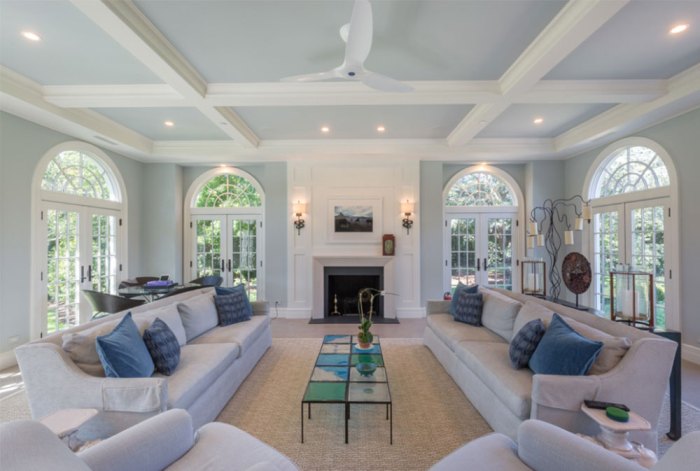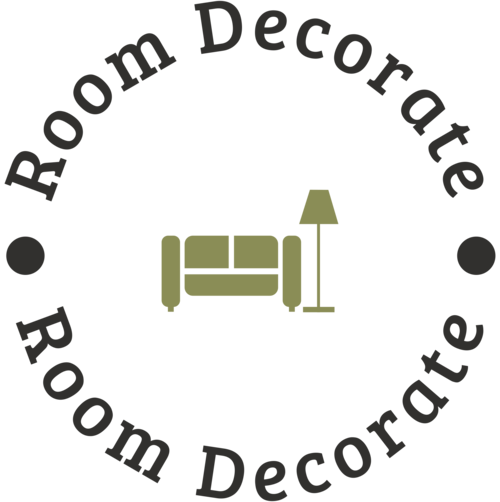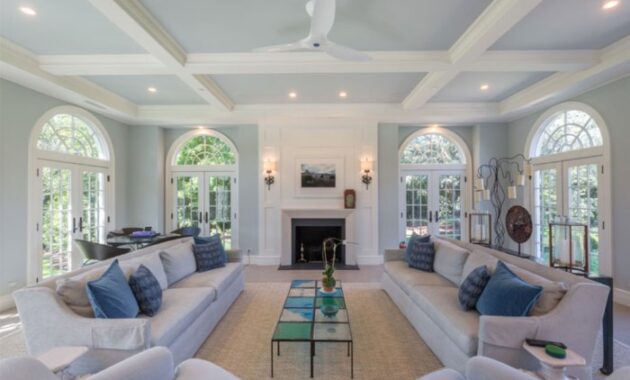How to decorate an extra large living room can seem daunting, but it’s an exciting opportunity to create a space that’s both grand and inviting. With a little planning and creativity, you can transform this expansive area into a comfortable and stylish haven.
The key is to create distinct zones within the space, define focal points, and select furniture that complements the room’s scale. This will ensure that the room feels welcoming and balanced, rather than overwhelming.
This guide will walk you through the process of decorating an extra large living room, covering everything from choosing the right furniture and colors to adding personal touches that make the space truly your own. Whether you’re looking to host large gatherings or create a cozy retreat, this guide has everything you need to make your extra large living room a space you’ll love.
Furniture Selection and Arrangement
An extra-large living room offers a blank canvas for creating a space that is both stylish and functional. Choosing the right furniture and arranging it thoughtfully can transform your living room into a welcoming haven.
Furniture Selection
The key to selecting furniture for a large living room is to choose pieces that are both substantial and proportionate to the room’s scale. Large furniture will help to fill the space and prevent it from feeling empty.
- Consider the Room’s Shape and Layout:A rectangular room can benefit from a symmetrical layout, while an L-shaped room may call for a more asymmetrical arrangement.
- Choose Furniture with a Variety of Heights:Mixing high and low furniture pieces creates visual interest and helps to define different areas within the room. For example, a tall bookcase can balance out a low coffee table.
- Incorporate Statement Pieces:A large living room is the perfect place to showcase statement furniture pieces, such as a grand sofa or a unique coffee table. These pieces will act as focal points and add character to the space.
Furniture Arrangement
Arranging furniture in a large living room is about creating flow and functionality. Consider the different areas you want to define within the room, such as a seating area, a dining area, or a workspace.
- Create Conversation Areas:Group furniture pieces together to create intimate conversation areas. For example, a sofa, two armchairs, and a coffee table can create a cozy and inviting space.
- Use Rugs to Define Spaces:Rugs are a great way to define different areas within a large living room. Place a rug under your seating area, for example, to create a distinct space.
- Leave Space for Traffic Flow:Ensure that there is enough space for people to move around comfortably. Allow at least 3 feet of clearance between furniture pieces.
Seating Arrangements for Large Gatherings and Intimate Settings
Consider the types of gatherings you’ll be hosting in your living room when deciding on seating arrangements.
- Large Gatherings:For large gatherings, opt for modular seating options, such as sectional sofas, that can be easily rearranged to accommodate different group sizes. You can also incorporate ottomans or poufs for additional seating.
- Intimate Settings:For intimate gatherings, create a cozy and inviting atmosphere with a smaller seating arrangement, such as a sofa and two armchairs. Consider placing a fireplace or a focal point at the end of the seating area to draw people together.
Color Palette and Lighting

Color and light are powerful tools that can transform the feel of a large living room. By choosing the right colors and lighting, you can create a space that is both inviting and functional.
The Impact of Color on Room Size, How to decorate an extra large living room
The color palette you choose for your large living room can significantly impact its perceived size. Lighter colors like whites, creams, and pastels can make a room feel more spacious and airy. They reflect light, making the room appear larger and brighter.
In contrast, darker colors can make a room feel smaller and more intimate. They absorb light, creating a cozy and dramatic ambiance.
Creating a Color Palette
When selecting a color palette, consider the room’s natural light and the mood you want to create. For example, a living room with large windows and abundant natural light can accommodate bolder colors. A room with less natural light might benefit from a lighter palette to enhance brightness.
Consider the following tips:
- Start with a neutral base:Choose a light neutral color for the walls, such as white, cream, or light gray. This will create a clean and spacious backdrop for your furniture and decor.
- Add accent colors:Introduce accent colors through furniture, rugs, throw pillows, and artwork. These colors can add personality and warmth to the space. You can use two or three accent colors, ensuring they complement each other and the neutral base.
- Use color to define zones:If your living room has multiple zones, such as a seating area and a dining area, you can use color to differentiate them. For instance, you could paint the dining area walls a slightly darker shade than the seating area walls.
Lighting Options and Effects
Lighting plays a crucial role in setting the mood and ambiance of a large living room. Different lighting options can create a range of effects, from bright and cheerful to warm and inviting. Here’s a table comparing different lighting options and their effects:
| Lighting Option | Effect |
|---|---|
| Natural Light | Bright, airy, and energizing. Ideal for spaces with large windows. |
| Overhead Lighting | Provides general illumination. Can be harsh if not diffused properly. |
| Recessed Lighting | Provides even and subtle illumination. Suitable for highlighting specific areas. |
| Pendant Lights | Add a decorative touch and provide focused light. Can be used over dining tables or seating areas. |
| Floor Lamps | Offer adjustable lighting and can be used to create cozy corners. |
| Table Lamps | Provide task lighting and add warmth to a space. |
| Accent Lighting | Highlights artwork, sculptures, or other decorative elements. |
Remember to layer different lighting options to create a well-lit and inviting living room. For instance, you could use overhead lighting for general illumination, pendant lights over a dining table, and table lamps for task lighting.
Accent Pieces and Accessories

Accent pieces are the finishing touches that elevate a living room from functional to fabulous. They infuse personality, add visual interest, and tie the entire design together.
Choosing Accent Pieces
The key to selecting the right accent pieces is to consider their role in enhancing the room’s overall style and color palette. Here are some ideas:
- Sculptural Vases:A statement vase filled with fresh flowers or dried botanicals adds a touch of elegance and artistry. Choose a vase with a unique shape or texture that complements the room’s aesthetic.
- Throws and Pillows:These soft furnishings introduce pops of color, texture, and comfort. Opt for throws and pillows in fabrics and patterns that complement the furniture upholstery and the room’s overall theme.
- Wall Art:Artworks, photographs, or mirrors create focal points and inject personality into the space. Consider pieces that reflect your interests, inspire conversation, or simply add visual appeal.
- Bookshelves and Display Cabinets:These provide a platform for showcasing treasured possessions, creating a curated display of books, decorative objects, and personal mementos.
- Rugs:Area rugs define zones within the room, add warmth and texture, and can serve as a foundation for the color palette. Choose a rug that complements the furniture and the overall style of the room.
Balancing Decoration and Functionality
While accent pieces add personality, it’s essential to strike a balance between decoration and functionality. Avoid cluttering the space with too many items. Consider the flow of traffic and ensure that the accent pieces don’t obstruct pathways or create visual noise.
Prioritize pieces that serve a dual purpose, such as a coffee table with storage space or a lamp with a built-in shelf.
Outcome Summary

Decorating an extra large living room is a journey of balancing scale, functionality, and personal style. By embracing the challenges of this expansive space, you can create a room that is both grand and intimate, a place where you can relax, entertain, and express your unique personality.
Remember to prioritize functionality, create visual interest with strategic placement, and personalize the space with meaningful accents. With a little planning and creativity, you can transform your extra large living room into a haven that reflects your individual style and brings you joy for years to come.
Questions and Answers: How To Decorate An Extra Large Living Room
What are some common mistakes to avoid when decorating an extra large living room?
Common mistakes include using furniture that is too small for the space, neglecting to define zones, and over-crowding the room with too many accessories. It’s important to create a balanced and harmonious look, rather than a cluttered one.
How can I create a sense of intimacy in a large living room?
You can create intimacy by using furniture groupings, rugs to define areas, and incorporating soft lighting and textures. This will help to break up the space and create a sense of coziness.
What are some tips for choosing the right rug for a large living room?
When choosing a rug, consider the size and shape of the room, as well as the scale of the furniture. A large rug can help to anchor the space and create a sense of unity. It’s also important to consider the color and pattern of the rug, as it will have a significant impact on the overall look of the room.

